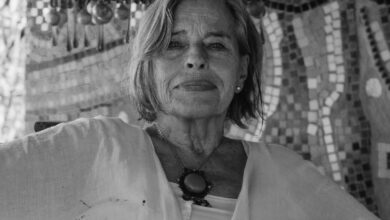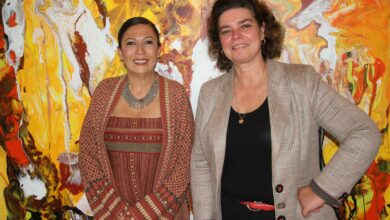Several flights up a dark stairwell waits the Contemporary Image Collective’s (CIC) current show, a solo exhibition from Egyptian artist Mahmoud Khaled called When Meanings Face Glossy Surfaces–five works that play with intimacy between strangers while questioning the role of the artist. Using an interdisciplinary approach, Alexandria-born Khaled investigates interactions between different forms of expression facilitated by the curatorial work of Aleya Hamza.
"The Studio as a Work of Art" (2010), "Google Me / Duplicate Self-Portrait" (2010), "Niche" (2009-10), "Safety Zoom" (2008-9) and cinematic portrait "This Show is My Business" (2008), all created in the last three years, incorporate photography, redefined everyday objects, and video.
"This Show is My Business" began by accident. After googling his own name, Khaled discovered London-based belly dancer Khaled Mahmoud. From this coincidence of their shared names, the two artists explore their societal roles as artists in a documentary-style portrait that elaborates particularly on the stereotypes that accompany a male belly dancer abroad.
In an interview, Mahmoud, the belly dancer, critiques audiences who enjoy belly dancing as a “cirque du soleil” and disregard skill in their fascination with the exotic. Poised in a large chair in front of a golden backdrop, this portrait plays off of celebrity interviews and connotes a similar sense of guarded vulnerability. Consistent with Khaled’s ongoing interest in cultural authenticity, this film is part of a wider research project consisting of candid interviews with other London-based performers. One of the strongest pieces in the exhibition, the film creates a compelling window into the personal difficulties of a man working abroad in a mostly female profession. The intimacy of the interview provokes questions as to what can be accurately observed, and this ties well into another piece, "Niche."
In a subtle and thought-provoking way, "Niche" touches upon forms of display and the viewer-artist relationship. Upon entry to the CIC exhibition space, an ornate vitrine of darkened wood stands against the wall holding a series of framed images–landscapes taken in Barcelona’s Montjuic Park, colored occasionally with the remnants of an abandoned cigarette butt or a beer can.
The photographs bear witness to intimate moments at a popular cruising spot in Spain, but also work independent of this geographical location. It is the very ambiguity of the images that allows the viewer a sense of recognition and familiarity. The mirrored background of the display case reminds the viewer of their role as observer.
Across the room "Google Me/ Duplicate Self-Portrait" (2010) hangs framed on the wall. Two video screen shots, paused at the same moment, remind the viewer of the ways in which artistic expression has been impacted by the Internet. Khaled’s reference to the accessibility of information online relates to the work of artists such as Johan Grimonperez.
"Safety Zoom" juxtaposes video with a familiar object in order to redefine that object. Framed in wood similar to that used in Niche, two life jackets have been punctured with many fishing hooks. While viewing "Safety Zoom," art history student Sana Venjari recalls Marcel DuChamp’s "Bicycle Wheel" (1951). “There’s an address to the fundamental question of investigating what can be used as art.” Peering closer at the life jackets, she asks, “Is it art because it’s been separated from its original intention and use?”
"Safety Zoom" questions authenticity. The room’s curtains and floral background echo the bourgeois connotations of the "Niche" vitrine. The dual format of the video, which depicts a happy family on a boat, draws attention to the malleability of the viewer’s perspective. Paired with a narration that describes the death of Princess Diana, this work continues the exhibition’s discussion of the authenticity of external appearances. The redefinition of an object by divorcing it from its original use is not a novel concept, but Khaled successfully creates his own interpretation of a Dadaist conception with the addition of this film.
The 200 canvases displayed in the adjoining room, "Studio as a Work of Art," reconfigure a traditional medium of the visual arts, the blank canvas, in order to continue thinking about the artist’s approach to a given work. The process of discussing art and participating in dialogues shown in the aforementioned "Google Me/Duplicate Self-Portrait" connects to the way this piece investigates the dynamics of the physical space of an artwork. The two-dimensional canvas has been transformed into a multi-dimensional sculpture.
An installation, by its very nature, invites interactions between strangers; namely, the patrons and the artist. In this way, When Meanings Face Glossy Surfaces itself questions the observant gaze that its individual pieces intend to provoke.
When Meanings Face Glossy Surfaces will be at Contemporary Image Collective from 14 December 2010 through 8 January 2011. The Contemporary Image Collective is at 22 Abdel Khalak Tharwat, 4th Floor, in downtown Cairo.




